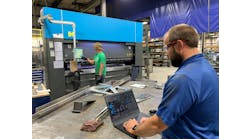Lines on a process flow diagram (PFD) indicate material flow. In contrast, on a piping and instrument diagram (P&ID), the control overlay for the PFD, the lines represent information flow. Material and information conveyance are different, and you need to understand the difference to understand the P&ID, and more so, to design a control strategy.
Companies seem to have individual nuances to both diagrams, but essentially, the PFD indicates process units and piping connections with a legend that has the steady-state design values of flow rate, temperature, pressure and composition of each stream. Drawings of the process units usually have a shape like a classic unit silhouette.
Generally, the P&ID shows the control devices and communication connections linking them overlaid on the PFD. The devices commonly have geometric shapes and identifications prescribed by ISA Standard ANSI/ISA-5.1.
It's important for newcomers to understand the distinction between process lines that convey material and communication lines that convey information. Consider that on a PFD, if a line is representing fluid with a 100 gpm flow rate and the line is split with one leg having 30 gpm, the other leg must have the complementary 70 gpm. The flow rate through the lines must preserve the material balance.
In general, the material and energy balance on any control volume on a PFD must close. In contrast, in a P&ID, communication lines mean data about something. The transmitting device might broadcast the message, “The flowrate of A15 is 100 gpm,” and if that information goes to two places such as a controller and a display, both hear “100 gpm.” The value is not split. Similarly, if 10,000 people in a stadium hear the announcer say, “The pitcher’s baseball speed was 90 mph,” they don’t each hear that the speed was 0.009 mph.
Device communication lines on a control overlay might refer to the flow rates, composition and state of the material being transported in the pipes. But the information communication also refers to states within a process, such as the level in the condensate receiver or the temperature on Tray 5. The P&ID lines could be transmitting the values of such internal states, even when these descriptions don't flow in or out.
On a P&ID, both the process flow lines and the controller information transmission lines are shown. To differentiate what they mean, I find it helpful to place the message each control device is “saying” in a dialog balloon, as it would be interpreted in human language.
Transmitting information
Each device transmits four pieces of information: who it is talking to, the label, the value and the units. Be sure you include all four. For instance, in a simple secondary flow control loop, the lower loop in a cascade strategy, the flow transmitter might be talking to the secondary controller and saying, “Hey FIC304, the reflux flow rate is 83 gpm.” Who it is addressing is “FIC304,” and the label is “reflux flow rate.” The magnitude is “83,” and the units are “gpm.”
The setpoint to the flow controller from a primary temperature controller might be telling the secondary controller, “Hey FIC304, your reflux flow rate setpoint is now 86 gpm.” After thinking about these messages for a bit, FIC304 tells the i/p device, “Hey FY304, tell the valve to go to 51% open.” Then FY304 says to the valve, “Hey, FCV304, go to 48% open.” (FY304 was not perfectly calibrated.)
To get students in my process control course to understand the meaning of the control signals, I have them add dialog balloons to all the control devices on a P&ID. Their answers are a strong indication of whether they understand the control devices. Some, for instance, have the controller saying, “Valve, the flow rate is too low, increase it.” Others think of the controller as a human brain, sending several disparate signals to each of several devices. One had the flow transmitter saying, “See the legend for a description of this stream.” Explicitly placing the communication discourse in balloons is a good way for beginners to self-assess that they understand the division of functions in a control loop. One student who got it was enjoyably creative in a distillation control design exercise. He used a Star Trek context and mimicked how individuals from the USS Enterprise (NCC-1701) might address and send information to each other as if they were stationed on the P&ID.
If you do this, do it privately, not on the diagram that you're red lining for others to see the changes you want!
Understanding device language
In reality, the communication isn't in human language. Devices often communicate in a scaled-signal value (3-15 psi, 4-20 mA, % of full scale, binary counts, etc.). Although communication packets between devices on a local area network (LAN) would need to have the address, labels, values and units, the location of the communication lines between devices on a P&ID implicitly reveal most of that information. The transmission message only needs the scaled value of the magnitude. So, I instruct students to also include the “language” that the device is actually speaking in the device dialog exercise.
If the device language is percentage of full scale, then the value transmitted is %=100 (X−Xmin)/(Xmax−Xmin), where X is the value of the variable being described. If the device output is mA, then i=4+16(X−Xmin)/(Xmax−Xmin).
Instituting sanity checks
I also give students the following guide to apply as sanity checks for devices in a control loop they're designing:
1. Sensor/transmitters: Only one signal out. No signals in. Outgoing signal can only report the state, it can't interpret.
2. Final control elements: Only one information input. They might think, “Make up your mind, you keep telling me to change.” But there is no information out. You can't put two FCVs in series. Each final control element must have one, and only one, controller giving it directions.
3. Signal transducers: Have one signal in and one signal out. They only convert from one device language to another, such as current to pneumatic, or % to mA. Although the device language might change from 12 mA input to 9 psig output, the human language meaning of the signal is unchanged. To create an outgoing signal, transducers need a power source. It may be a battery or instrument air supply pressure.
4. Arithmetic function blocks: They can only do a simple calculation. They may have one or more input signals, but only one output. They can't comment on the context, but only reveal the result of the calculation. The operation may be a square root, a ratio, an addition or a difference. The human language interpretation of the inputs (label and units) must match what's needed in the arithmetic equation.
5. Select blocks: Have two or more inputs and one output. All inputs must have the same label, category and units as the output.
6. Controllers: Usually, they have two inputs, CV and SP, and one output, CO. The two inputs must have the same label and units. The output could go to the final element or to another device such as a multiplication block or a controller. If external reset feedback (erf) is used, then the controller has a third input, the erf signal, which must be exactly the same as the controller output when the controller is actively in charge. The controller doesn't judge or interpret. It only does a simple calculation, then provides an output that's a statement of information for the subsequent device to use. One controller can only have an output instruction to one final control element.
7. Signals: Must have a source. Most are within the control loop, but a SP may be manually input. Information signals can split and convey the exact same information to any number of devices. Information signals can only be combined in function blocks.
'Smart' devices
Of course, “smart” devices can transmit additional information about their internal state, and they might be measuring several aspects of a process, not just one. But don’t think that the term “smart” means that the devices can interpret or understand. Also, when devices are on a LAN, the signal outputs and inputs aren't directly connected from one device to the other. When using multivariable controllers, there may be several inputs and outputs to the single controller. Once novices get the basics, as outlined above, they can move toward adding new features to the communications.
I encourage college instructors to duplicate these exercises with their students, and my hope is that this article will help novices in their careers develop their potential.





